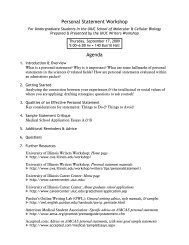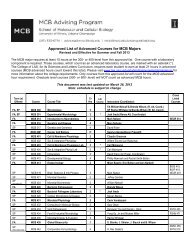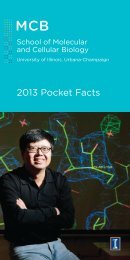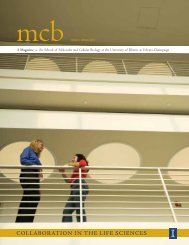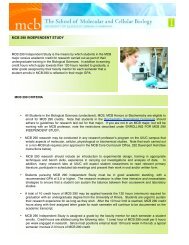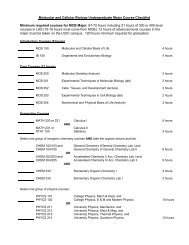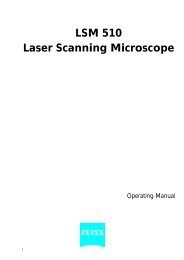breast cancer research • mcb as pre-med - The School of Molecular ...
breast cancer research • mcb as pre-med - The School of Molecular ...
breast cancer research • mcb as pre-med - The School of Molecular ...
Create successful ePaper yourself
Turn your PDF publications into a flip-book with our unique Google optimized e-Paper software.
enIta Katzenellenbogen<br />
“We now understand the underpinnings <strong>of</strong> <strong>cancer</strong> much more so than ever before,” says<br />
Benita Katzenellenbogen, Swanlund Pr<strong>of</strong>essor <strong>of</strong> <strong>Molecular</strong> and Integrative Physiology and<br />
Swanlund Pr<strong>of</strong>essor <strong>of</strong> Cell and Developmental Biology.<br />
Katzenellenbogen h<strong>as</strong> worked for much <strong>of</strong> her career to understand the biology <strong>of</strong> the ER<br />
and how and why “selective estrogen receptor modulators” (SERMs) like tamoxifen and<br />
raloxifene work.<br />
SERMs, common and useful drugs for endocrine therapies, bind to the estrogen receptor,<br />
blocking estrogen. When estrogen cannot bind to the ER, <strong>bre<strong>as</strong>t</strong> <strong>cancer</strong> cells cannot proliferate<br />
<strong>as</strong> e<strong>as</strong>ily.<br />
Among the other findings from her lab, Katzenellenbogen’s group h<strong>as</strong> shown that when<br />
SERMs bind to the ER, they put the ER into a different conformation. “As a consequence,<br />
they antagonize the stimulatory activities <strong>of</strong> the receptor and can quite effectively reduce<br />
proliferation and incre<strong>as</strong>e apoptosis,” she says.<br />
Katzenellenbogen also h<strong>as</strong> found that ERs encode proteins for about 5% <strong>of</strong> genes in the<br />
<strong>bre<strong>as</strong>t</strong> <strong>cancer</strong> cell genome, meaning that 1,000 or more genes are regulated by this ER. It’s<br />
because the ER regulates these genes that it h<strong>as</strong> such an important effect in <strong>bre<strong>as</strong>t</strong> <strong>cancer</strong><br />
cells, says Katzenellenbogen.<br />
Related to understanding the cell biology <strong>of</strong> <strong>bre<strong>as</strong>t</strong> <strong>cancer</strong> tumors is the need to understand<br />
drug-resistant <strong>bre<strong>as</strong>t</strong> <strong>cancer</strong>s. Her lab h<strong>as</strong> identified a protein that is u<strong>pre</strong>gulated during<br />
treatment with tamoxifen. <strong>The</strong> <strong>pre</strong>sence <strong>of</strong> that protein is <strong>as</strong>sociated with a poor treatment<br />
outcome. Katzenellenbogen is confident that this protein is <strong>as</strong>sociated with <strong>bre<strong>as</strong>t</strong> <strong>cancer</strong>’s<br />
ability to resist tamoxifen. Her lab is now investigating whether reducing the level <strong>of</strong> this<br />
protein can lead to more successful treatment.<br />
Benita S. Katzenellenbogen is a Fellow <strong>of</strong> the<br />
American Academy <strong>of</strong> Arts and Sciences and<br />
recently served <strong>as</strong> <strong>pre</strong>sident <strong>of</strong> the Endocrine<br />
Society. She h<strong>as</strong> published more than 300<br />
<strong>research</strong> articles and co-edited a book on<br />
“Hormone-Dependent Cancer.”<br />
In 2009, Pr<strong>of</strong>essor Katzenellenbogen received<br />
the Susan G. Komen for the Cure Brinker<br />
Award for Scientific Distinction in b<strong>as</strong>ic science<br />
and clinical <strong>research</strong>. this is the highest award<br />
<strong>of</strong> merit given by the nation’s leading <strong>bre<strong>as</strong>t</strong><br />
<strong>cancer</strong> activism organization.<br />
Nancy G. Brinker promised her dying sister,<br />
Susan G. Komen, she would do everything<br />
in her power to end <strong>bre<strong>as</strong>t</strong> <strong>cancer</strong> forever.<br />
In 1982, that promise became Susan G.<br />
Komen for the Cure, and launched the global<br />
movement to cure <strong>bre<strong>as</strong>t</strong> <strong>cancer</strong>.<br />
SCHOOL OF MOLECULAR AND CELLULAR BIOLOGY . 5



